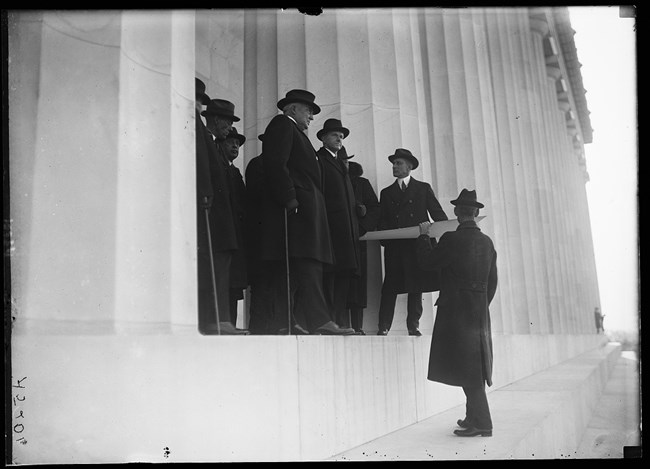|
Visit our keyboard shortcuts docs for details
Watch to learn more about Arlington Memorial Bridge's history and significance. 
Library of Congress / Harris & Ewing Collection Learn more by reading the Historic American Engineering Record's report on Arlington Memrorial Bridge. Based on an article by Richard F. Weingroff Arlington Memorial Bridge is one of the Washington area’s most beautiful bridges. What seems like such a great, even obvious, idea today was conceived in the 19th century and succumbed to the fate of so many monumental projects: delay. A traffic jam prodded it along. In a speech on July 4, 1851, Secretary of State Daniel Webster attributed the idea for a bridge at this general location to President Andrew Jackson (1829-1837). No one succeeded at moving the project ahead for almost 100 years. On November 11, 1921, President Warren G. Harding was on his way to Arlington National Cemetery for the dedication of the Tomb of the Unknown Soldier. His car got stuck in what the Associated Press called “the worst traffic jam the National Capital has seen in many years.” The jam, apparently started when a small touring car ran out of gas on the Highway Bridge (successor to the Long Bridge), and kept thousands of people from reaching the ceremony. In response to the the traffic jam, Harding was personally involved in moving the project ahead. On December 18, 1922, President Harding and Vice President Calvin Coolidge met with members of the Commission of Fine Arts. After a brief discussion, they took White House cars to see sites for the bridge. President Harding expressed his preference for the Lincoln Memorial site as the best alternative for residents and tourists. Not long after, the Commission moved ahead with plans for a bridge to link the north and south between the Lincoln Memorial and Arlington House. From design to completion took another decade, spanning the death of President Harding on August 2, 1923, the administration of President Calvin Coolidge, the election of former Secretary of Commerce Herbert Hoover as President, and the start of the Depression. Officials arranged the opening of Arlington Memorial Bridge to coincide with the opening of the Mount Vernon Memorial Highway, even though neither was fully completed. In 1928, President Coolidge had signed legislation authorizing construction of the highway in anticipation of the 200th anniversary in 1932 of the birth of George Washington. The Bureau of Public Roads (BPR) designed and built the 15-mile road as a parkway from Washington’s home at Mount Vernon to Arlington Memorial Bridge. This road eventually became part of the George Washington Memorial Parkway. Finally, nearly 80 years after Secretary Webster spoke of the bridge that would link North and South, the bridge was ready for traffic, if not quite completed. The bridge, built by the U.S. Army Corps of Engineers at a cost of $6,650,000, did not have lighting for nighttime traffic. Officials had not agreed on “the final design of illumination, in keeping with the dignity of the project.” The Commission of Fine Arts would determine the design for additions to the bridge. The final touches were not completed until September 1933. Many years later, The Washington Post published a special feature about Washington area bridges. Regarding Arlington Memorial Bridge, the article stated
|
Last updated: January 27, 2020
